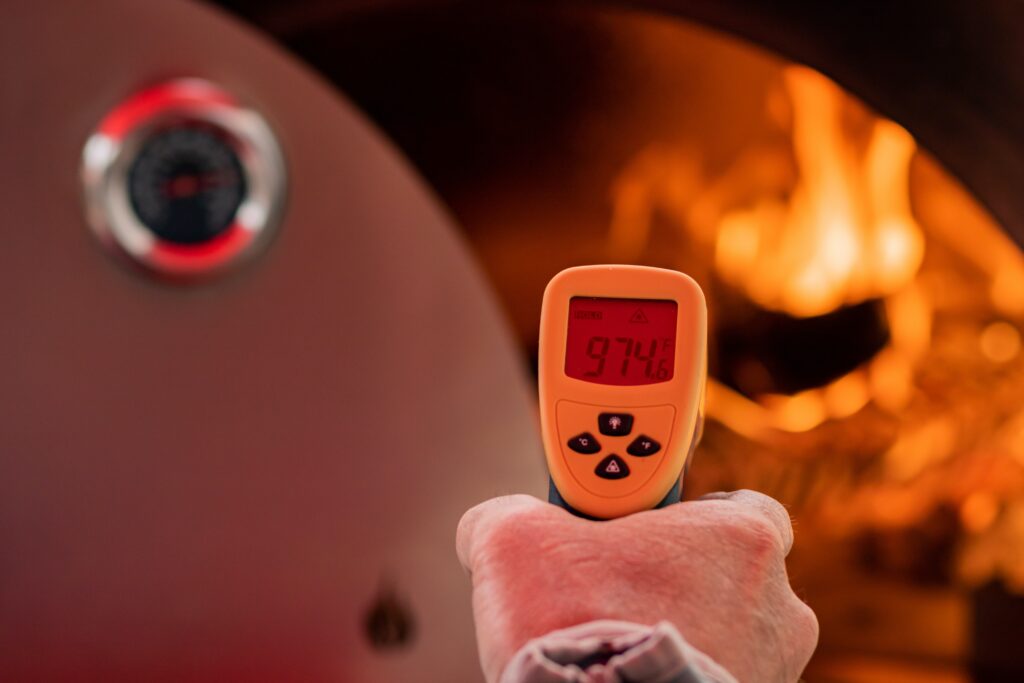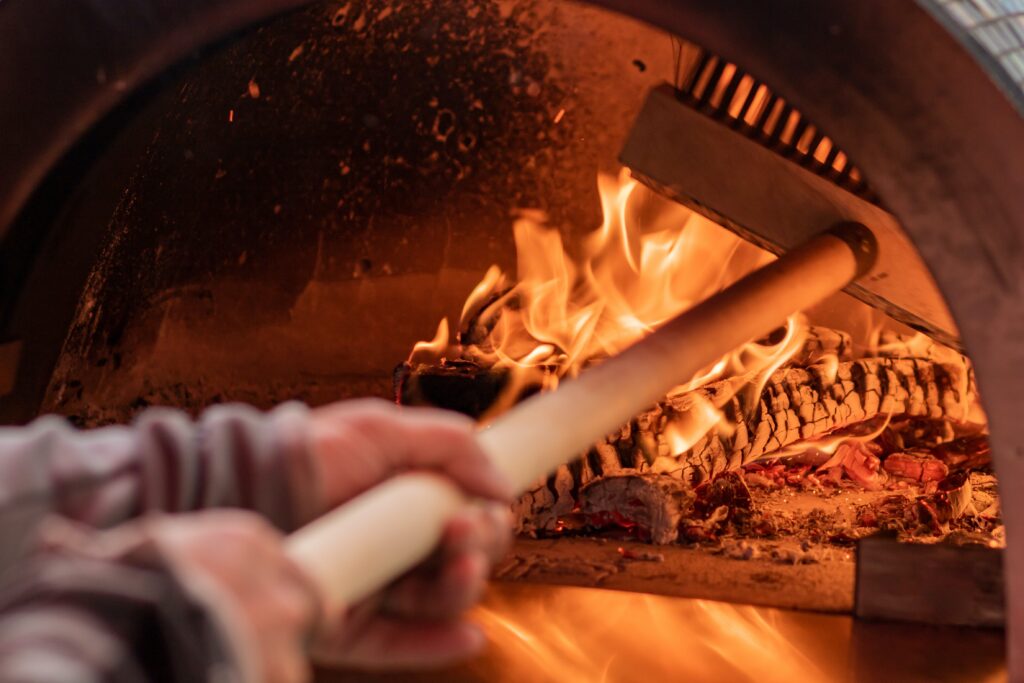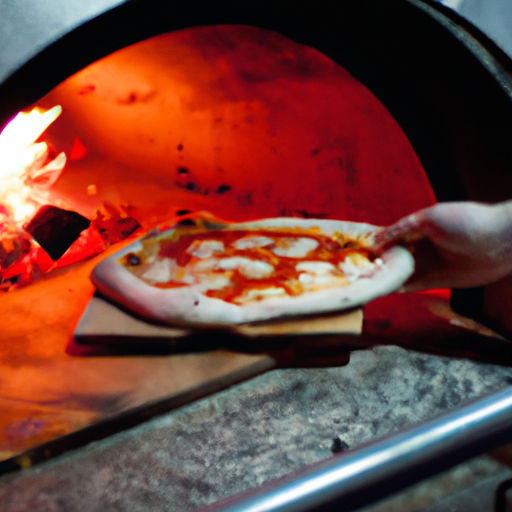Imagine sinking your teeth into a piping hot slice of pizza, the cheese stretching endlessly as you take that first savory bite. Have you ever wondered how that perfect slice was crafted? Look no further, for we’re about to unveil the mystery behind the magic – “How Does Pizza Oven Work?” In this article, we will take you on a journey through the inner workings of a pizza oven, unraveling the secrets to achieving that crispy crust, perfectly melted cheese, and mouthwatering toppings.
In the first part, we will explore the two main types of pizza ovens: traditional wood-fired ovens and modern gas or electric ovens. We will delve into the different techniques and mechanics behind each, understanding how they cater to different preferences and deliver unique flavor profiles. With a dash of history and a sprinkle of science, we will unlock the ancient origins of pizza making and the evolution of these ovens throughout time. So, whether you’re an aspiring pizzaiolo or simply a curious food lover, grab yourself a slice and join us as we demystify the art of the pizza oven.
Types of Pizza Ovens
When it comes to making delicious, authentic pizzas, having the right type of pizza oven is essential. There are several different types of pizza ovens available, each with its own unique characteristics and benefits. Whether you prefer the traditional taste of wood-fired pizza or the convenience of an electric oven, there is a pizza oven out there that will suit your needs perfectly.
Wood-Fired Pizza Ovens
If you’re a fan of that classic, smoky flavor that you find in traditional Italian pizzas, then a wood-fired pizza oven is the perfect choice for you. These ovens are typically made out of durable materials such as brick or stone, which helps to retain heat and distribute it evenly throughout the cooking process.
One of the key components of a wood-fired pizza oven is the wood itself. Wood serves as both the fuel source and the flavor enhancer, giving your pizzas that distinct smoky taste that you just can’t achieve with other types of ovens. The firing process in a wood-fired oven involves building a fire directly within the oven chamber, allowing the flames and heat to circulate and cook the pizza to perfection.
Gas Pizza Ovens
For those who value convenience and versatility, gas pizza ovens are a fantastic option. These ovens are powered by gas, typically propane or natural gas, which provides a consistent heat source for even cooking. Gas pizza ovens can often be found in pizzerias and restaurants where a high volume of pizzas are being cooked at once.
The burners in a gas pizza oven are responsible for heating the chamber and cooking the pizza. These burners allow for precise temperature control and even heat distribution, ensuring that each pizza comes out perfectly cooked. Flame control is another feature of gas pizza ovens, allowing you to adjust the flame intensity to suit the specific requirements of each pizza.
Electric Pizza Ovens
Electric pizza ovens are the epitome of convenience and ease of use. These ovens are powered by electricity and can be found in both residential and commercial settings. Electric ovens are known for their rapid heating capabilities, making them ideal for those who want to cook their pizzas quickly.
The heating element in an electric pizza oven is responsible for generating the heat needed to cook the pizza. These heating elements can be made from a variety of materials, such as quartz or ceramic, and are designed to distribute heat evenly throughout the chamber. Temperature control is another advantage of electric ovens, allowing you to set and maintain the desired temperature for perfect cooking results.
Convection Pizza Ovens
Convection pizza ovens utilize a unique cooking method that involves forced air technology. These ovens are equipped with a fan that helps to circulate the heated air throughout the chamber, ensuring that the pizza is cooked evenly and efficiently. Convection ovens are commonly found in commercial kitchens where large quantities of pizzas need to be cooked quickly.
One of the main benefits of convection ovens is their efficient cooking process. The fan in these ovens helps to distribute heat more evenly, reducing cooking times and ensuring that each pizza is cooked to perfection. Temperature control is also an important feature in convection ovens, allowing you to adjust the temperature as needed for different types of pizzas.
Basic Components of a Pizza Oven
No matter which type of pizza oven you choose, there are a few basic components that all pizza ovens share. These components work together to create the optimal cooking environment for your pizzas, ensuring that they come out crispy, flavorful, and delicious every time.
Chamber
The chamber of a pizza oven is where the magic happens. It is the enclosed space where the pizza is placed to cook. The size and shape of the chamber can vary depending on the type of pizza oven, but all chambers are designed to retain heat and provide an even cooking surface. The materials used to construct the chamber play a crucial role in heat retention and distribution.
Fuel Source
The fuel source is what powers the pizza oven and generates the necessary heat for cooking. Wood-fired ovens use wood as the fuel source, while gas ovens use propane or natural gas. Electric ovens, as the name suggests, rely on electricity to generate heat. Convection ovens typically use gas or electricity as their fuel source, depending on the specific model.
Heating Element
The heating element is responsible for generating the heat needed to cook the pizza. In wood-fired ovens, the heat is produced by the fire burning within the oven chamber. Gas ovens have burners that produce a flame, which generates the heat. Electric ovens use heating elements made of quartz or ceramic, which are heated through an electric current. Convection ovens rely on a combination of a heating element and forced air technology to generate heat.
Insulation
Insulation is an important component of any pizza oven as it helps to retain heat within the chamber and prevent heat loss. Insulation materials can vary depending on the type of pizza oven, but common materials include ceramic fiber, refractory bricks, and insulation blankets. Proper insulation ensures that the oven can reach and maintain the desired temperatures for optimal pizza cooking.

Wood-Fired Pizza Ovens
Wood-fired pizza ovens are often regarded as the gold standard when it comes to making authentic, delicious pizzas. These ovens have been used for centuries in Italy and are known for producing pizzas with a unique, smoky flavor and a perfectly crispy crust.
Wood as Fuel
One of the defining features of wood-fired pizza ovens is their use of wood as the fuel source. The type of wood used can have a significant impact on the flavor of the pizza. Different types of wood, such as oak, cherry, or maple, can add distinct flavors and aromas to the pizza. Wood-fired ovens also allow for the use of wood chunks or chips that have been soaked in water or flavored liquids, adding even more flavor to the pizzas.
External Structure
Wood-fired pizza ovens are typically constructed with durable materials such as brick or stone. These materials help to retain heat and distribute it evenly throughout the oven chamber. The external structure of the oven is designed to withstand high temperatures and provide insulation to ensure optimal cooking conditions.
Internal Structure
The internal structure of a wood-fired pizza oven typically consists of a dome or arched shape. This design helps to reflect and distribute heat evenly throughout the chamber. The dome shape also allows for proper airflow, ensuring that the flames and heat circulate around the pizza for an even cook.
Firing Process
To cook pizza in a wood-fired oven, the firing process is crucial. It involves building a fire directly within the oven chamber, allowing the flames and heat to circulate and cook the pizza. The fire is typically started with kindling and small pieces of wood, gradually adding larger pieces as the fire grows stronger. It is important to let the fire burn for some time to heat the oven chamber before placing the pizza inside.
Gas Pizza Ovens
Gas pizza ovens are a popular choice among commercial pizzerias and restaurants due to their convenience and efficiency. These ovens are powered by either propane or natural gas, providing a consistent heat source for cooking pizzas.
Gas as Fuel
The use of gas as the fuel source in these ovens offers several advantages. Gas is a clean-burning fuel, producing minimal smoke and reducing the risk of residue or soot buildup on the pizzas. It is also readily available and easily accessible, making it a convenient option for home or commercial use.
Burners
Gas pizza ovens are equipped with burners that produce a flame for cooking the pizzas. These burners can be located at the bottom, back, or sides of the oven chamber, depending on the specific design of the oven. The number and placement of the burners can vary, but the goal is to ensure that the heat is evenly distributed throughout the chamber.
Flame Control
One of the advantages of gas pizza ovens is the ability to control the intensity of the flame. This allows for precise temperature control and the ability to adjust the heat based on the specific requirements of each pizza. Whether you need a high heat for a quick-cooking pizza or a lower heat for a slower, evenly cooked pizza, gas ovens provide the flexibility to achieve the desired results.
Temperature Regulation
Gas pizza ovens typically come with temperature control knobs or dials that allow you to set and maintain the desired cooking temperature. The temperature can be adjusted based on the type of pizza being cooked and personal preferences. This ensures that the pizzas are cooked evenly and to perfection every time.

Electric Pizza Ovens
Electric pizza ovens offer a convenient and efficient way to cook delicious pizzas in the comfort of your own home or in a commercial setting. These ovens are powered by electricity and are known for their rapid heating capabilities.
Electricity as Power Source
Electric pizza ovens rely on electricity to generate the heat needed for cooking. This makes them a convenient option for those who do not have access to wood or gas as a fuel source. Electricity is widely available in most residential and commercial settings, making electric ovens a practical choice for a wide range of pizza enthusiasts.
Heating Elements
The heating element in an electric pizza oven is responsible for generating the heat required to cook the pizza. These heating elements are typically made of materials such as quartz or ceramic, which can withstand high temperatures and distribute heat evenly. The location and number of heating elements can vary depending on the design of the oven, but the goal is to ensure that the pizza is cooked uniformly.
Temperature Control
Electric pizza ovens offer precise temperature control, allowing you to easily set and maintain the desired cooking temperature. This is particularly useful when cooking different types of pizzas that require specific temperature ranges. The ability to adjust the temperature ensures that the pizzas are cooked to perfection, with the right balance of crispness and tenderness.
Convection Pizza Ovens
Convection pizza ovens utilize forced air technology to cook pizzas quickly and effectively. These ovens are commonly found in commercial kitchens and are ideal for cooking large quantities of pizzas in a short amount of time.
Forced Air Technology
The main feature of convection ovens is their use of forced air technology. These ovens are equipped with a fan that helps to circulate hot air throughout the chamber. This constant circulation of hot air ensures that the pizza is cooked evenly and efficiently.
Fan and Heat Distribution
The fan in convection ovens plays a crucial role in distributing the heat evenly. It helps to move the hot air around the chamber, ensuring that the pizza cooks evenly on all sides. This eliminates the need to constantly rotate the pizza during the cooking process, saving time and effort.
Efficient Cooking
Convection ovens are known for their rapid cooking capabilities. The forced air technology allows for faster heat transfer, reducing cooking times significantly. This makes convection ovens a popular choice for commercial kitchens where speed and efficiency are essential.
Temperature Control
Like other types of pizza ovens, convection ovens offer temperature control options. This allows you to adjust the temperature based on the specific requirements of each pizza. Whether you need a high temperature for a quick-cooking pizza or a lower temperature for a slower, more even cook, convection ovens provide the flexibility to achieve the desired results.

The Cooking Process
Now that we’ve covered the different types of pizza ovens and their components, let’s delve into the cooking process itself. The way you cook your pizza can greatly affect its taste, texture, and overall quality.
Preheating
Before placing your pizza in the oven, it’s essential to preheat the oven to the desired temperature. Most pizza ovens require preheating to ensure that the cooking surface reaches the necessary heat for optimal pizza cooking. The preheat time can vary depending on the type of oven, but it’s typically recommended to preheat for at least 30 minutes to ensure the oven has reached the desired temperature.
Pizza Placement
Once the oven is preheated, it’s time to place your pizza in the oven. Depending on the type of oven, you may place the pizza directly on the cooking surface, on a baking stone, or on a pizza peel. It’s essential to follow the manufacturer’s instructions for properly placing the pizza in the oven to ensure even cooking and prevent any mishaps.
Heat Transfer
The cooking process in a pizza oven involves the transfer of heat from the oven’s heat source to the pizza. The heat source, whether it’s wood, gas, electric, or forced air, generates heat that circulates around the pizza, cooking it from top to bottom. The cooking time can vary depending on the thickness of the crust, the toppings, and personal preferences.
Baking Time
The baking time for a pizza can vary depending on several factors, including the type of oven, the temperature, and the toppings used. In general, pizzas cooked in wood-fired ovens tend to cook faster due to the high temperatures reached in these ovens. Electric and gas ovens typically have a slightly longer cooking time. However, it’s important to monitor the pizza throughout the cooking process to ensure it reaches the desired level of doneness.
Advantages of Pizza Ovens
Using a pizza oven to cook your pizzas offers several advantages compared to other cooking methods. Whether you’re a professional chef or a home cook, these advantages can greatly enhance your pizza-making experience.
High Temperature
One of the main advantages of pizza ovens is their ability to reach high temperatures that are often unattainable in other types of ovens. The high temperatures in wood-fired and gas ovens can create a perfect balance of crispy crust, melted cheese, and thoroughly cooked toppings, resulting in a true Neapolitan-style pizza.
Rapid Cooking
Pizza ovens can cook pizzas much faster than traditional ovens. This is especially true for wood-fired and convection ovens, where the high heat and forced air technology significantly reduce cooking times. This makes pizza ovens a great option for those who want to cook pizzas quickly, whether it’s for a weeknight dinner or a large gathering.
Better Flavors
The unique features of pizza ovens, such as wood-fired flavor or precise temperature control, can greatly enhance the flavors of your pizzas. Wood-fired ovens infuse the pizzas with a distinct smoky flavor that’s hard to replicate. Gas ovens allow for controlled heat and even distribution, resulting in a well-cooked and flavorful pizza. Electric ovens offer consistent and efficient heat, ensuring that each pizza comes out perfectly cooked.
Crispy Crust
One of the hallmarks of a great pizza is its crispy crust. Pizza ovens excel in creating perfectly crisp and golden crusts. The high temperatures and even heat distribution in these ovens help to achieve that ideal balance between a crunchy exterior and a soft, chewy interior.
Versatility
Pizza ovens are not just for pizza. These versatile appliances can be used to cook a wide range of dishes, including bread, roasted vegetables, and even desserts. The even heat distribution and high temperatures in pizza ovens make them a great tool for various cooking techniques, expanding your culinary possibilities beyond just pizza.
Choosing the Right Pizza Oven
With so many different types of pizza ovens available, choosing the right one can seem overwhelming. However, considering a few key factors can help you narrow down your options and find the perfect pizza oven for your needs.
Intended Use
Before purchasing a pizza oven, consider how you plan to use it. Are you a professional chef looking to add wood-fired pizzas to your menu? Or are you a home cook who wants to occasionally indulge in homemade pizzas? Understanding your intended use will help you determine the size, features, and heating capabilities needed for your pizza oven.
Space and Size
Another crucial factor to consider is the amount of space you have available for your pizza oven. Measure the area where you plan to install the oven and ensure that there is sufficient room for the oven itself, as well as any necessary ventilation or safety precautions. Additionally, consider the size of the oven chamber and whether it can accommodate the size of pizzas you plan to cook.
Construction Material
The construction material of the pizza oven can impact its performance and durability. Common materials used in pizza oven construction include brick, stone, stainless steel, and ceramic. Each material has its own advantages and considerations, such as heat retention, insulation, and maintenance requirements. Research the pros and cons of each material to determine which one best suits your needs.
Budget
Of course, your budget will also play a role in your decision-making process. Pizza ovens can vary greatly in price, with wood-fired ovens typically being more expensive than gas or electric ovens. Consider how much you are willing to invest in a pizza oven and prioritize the features that are most important to you.
Conclusion
Investing in a pizza oven can elevate your pizza-making game to new heights. Whether you choose a wood-fired oven for that classic smoky flavor, a gas oven for convenience, an electric oven for rapid heating, or a convection oven for efficiency, the right pizza oven will make a world of difference in the taste and quality of your pizzas. Consider the type of oven that aligns with your cooking preferences and explore the different components that contribute to a perfect pizza cooking experience. With a little practice and the right pizza oven, you’ll soon be enjoying delicious, homemade pizzas that rival those from your favorite pizzeria.

